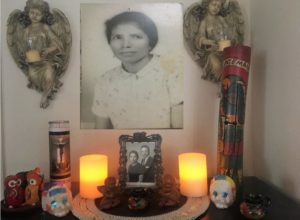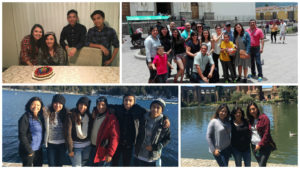
Juana Gomez Avila
Juana Gomez was born January 31, 1942, she was the youngest of 11 siblings. She married Enrique Avila in the summer of 1962, and had 7 children. She was a great mother, daughter, aunt, cousin and grandma. Juana passed away September 29, 1984 after having chest pain which was then determined to be a heart attack. She was only 42 years old when she passed away, leaving her children and husband to fend for themselves. My youngest aunt was 13 years old, and my mother was 17 years old. My grandmother’s history and legacy lives vicariously through storytelling, pictures, and few personal belongings. I honored my grandmother by doing an altar for Día De Los Muertos, she a person who has influenced my mom and my family. Although she is not physically present in our lives, she is someone we always include and pray for. My family members like my cousins, sister and brothers were not able to meet her, but we all feel her presence and honor her birthday and the day she passed.
My grandmother was young when she married, but with only being 20 she knew it was a good age to marry. She married around the 60’s, and for that time in Guatemala being 20, “el tren casi la dejaba”, translation, the train almost left her, meaning her window for marriage was already starting to close. Immediately after marrying she had my uncle, my aunt and then my mom, and so on she had children every other year. This was something traditional in Guatemala, to marry young, have as many children as god can give you, and work until you can’t any more. My grandmother worked in a Nivea factory, and my grandpa wore many hats. He at one point was a delivery pharmacist, a mechanic and even a carpenter. And this according to “Guatemalan tradition” was not traditional, usually women stay at home, mend the house, raise the children, and have food on the table, but having 7 children required both parents to work.
I don’t have any personal stories or memories of my grandmother, all I have are the stories my mom and family members have told me. My mom rarely spoke about her mother when I was younger, most of the stories weren’t in the best either. My mother was only 17 when my grandma past away, being in her teens, my mom wasn’t able to make a real connection with her. My mom remembers my grandmother being harsh and even cold towards her. Very few times did they ever spend mother-daughter quality time together, for my grandmother saw my mother as the “go-too” of the family. My grandmother was the youngest of her 11 brothers and sisters, so as the baby of the family, she was never told to clean, cook, or help around the house as much as her other siblings. And when she married and had children, she found it difficult to adjust to cleaning, cooking, raising kids, and having a house and husband. My mom took most of the responsibility as the one of the older siblings to be in charge of the house, because my grandmother was always working.
In my recent trip to Guatemala, I spoke to my grandpa, aunts and uncles, who were the closest to her and lived with her. My family remembers my grandma being sweet, kind and always volunteering in her local church. Catholicism is important and has been carried on from both sides of my family. My grandma before passing, was a volunteer at her church and was also a Sunday teacher, she taught catechism to the younger children. With tears in his eyes, my tío Rolando told me she was the strongest women he had ever met, that there was no other woman like her. Tía Odillia was too young to remember her well, but she remembers going to the market and always letting her buy candy. Alberto, my mom’s cousin, remembers my grandma as a loving mother, and aunt to him. My grandpa remembers her sweetly, and referred to her as Juanita, that there was no other women like her, “era una en un millón”, she was one in a million. He said he was honored to have shared the years he did with her. That there was no other love like her love. My family members including my mom, share different memories of my grandmother but they all were blessed and lucky to have shared a moment with my grandmother.
This information without knowing it, helped me create her altar. I made my first trip to Guatemala, Not meeting my grandmother, gave me the chance to carry a love for someone I have never met. Her love and her presence lives strongly in the familia Avila Gomez. For my altar I used the main image of her, floating between angles. In that picture she was about 30 years old. This is one of the pictures I was able to get from my trip. And the other picture in the frame, is the last picture taken of my grandma, it’s a black and white picture of her and my grandpa. These pictures are important for my family because, I was the first member of family to go to Guatemala since my mom and sister came to California. The images are now placed throughout the house, to honor my grandma and have the 4 pictures I brought back home. The candle to the left is El Señor De Esquipulas, which is a Cristo of Esquipulas a city in Guatemala.
This Cristo is important to my mom and dad. Similar to Pablo E. Martinez in Masculinity Reconfigured: Shaking up Gender in Chicano/Latino Literature, “Nationalism is the identity or way of being that pertains to a person’s nationality and heritage; it has more influence when that individual lives in the homeland or has just relocated, bringing those customs with him or her to the new country.” Our family has taken my parents customs, and adopted it to our life. My family goes to St. Joseph Catholic Church and we are members of El Señor De Esquipulas. We have carried family customs, and are believers of the same Cristo my grandmother believed in and prayed too.
The owls on the left are owls that family member have brought from Guatemala. The owls are important in our family because my family members in Guatemala love owls, for being rare in the city. The musical instrument to the right is my brother’s instrument that my dad brought us when he went to Guatemala. I used a lot of objects in my house that family friends have brought trough out the years. My mom has no belongings of my grandma so I was not able to use personal belongings of her. The sugar skulls I bought from my local market to keep the altar traditional. I respected my mom’s wishes, and decided not to use too many skulls. The angels that are by the image in the top, are actual candles, my mom only uses them to honor someone who has passed. The smaller angels by the picture frame below, are angles my mom has placed around the house, and thought it would be nice to add more angels to the altar. The candles in the bottom are candles I have in my room, I felt by lighting them and placing them close to my grandmother, she would see me honoring her. My family chooses not to do Día De Los Muertos altar’s because it’s not a Guatemalan tradition. And also being Catholic, it is not costumed to do Día De Los Muertos Altar. My mom and dad instead have small altars for our family members that have passed. We tend to make the altars when it’s the anniversary of the person’s passing. My family altars are also more religious, we use more angels, Cristo’s, roses, candles and flowers.
The honoring of my grandmother created a new conversation with my mom. She remembered the moment when they told her, her mom had passed away. Feeling shocked in hearing the news, and also the day of her burial. My tío Daniel, the oldest brother told me a story I had never heard before about my grandmother’s coffin. When my grandpa remarried, he left the family house and left my mom, aunts and uncles alone in the house. With that they had to pay all the bills including the monthly cemetery for my grandma. My family had trouble paying all the house bills, and the plot for my grandma. With no help from my grandpa, and from other family member, the cemetery proceeded to excavate the remains of my grandma, and through the coffin out. My grandmother was lost in Antigua and believed to have been tossed on the side of a mountain. Keeping in mind, the government in Guatemala isn’t so involved with their citizens, so this was normal to do in Guatemala. This is something my family mourns about, they are sadden that there is no place to go and leave her flowers or pay respect and visit.
What hurts me is never have been able to meet her. My grandpa says, that all his grandkids carry something of her, whether it’s her smile, eyes or even her gestures. My mom’s side of the family is all in Guatemala, which has really limited the chance to connect with them. My trip to Guatemala made me feel not only connected to my country, but also connected to her. Being with all my aunts, uncles, cousins and second cousins, made me feel her presence even more. I may have not met her, but I know she is with each one of her kids and grandkids.
The limited amount of time spent with my Avila family also limits the amount of information I know of my grandma. I had mentioned, my mother chooses not to speak about her too much. She said she feared us being sad, and miss someone we had never met before. My mom loved her, but she has held some resentment towards her, and unsolved issues with the family. I think my mom feels that way because, she never was able to deal with her emotions toward my grandma before and after passing.
No one is ever prepared to lose a family member. My mom may not admit it, but she hasn’t dealt with her mom’s passing. Seeing the altar made her happy, but also brought mixed emotions. When I mentioned the project, I asked for permission and she said it was fine. As I began to look at altars online she told me to please not use black colors, skulls or anything that was to “Halloween” for her. I did the altar in her room, and she asked me to do the altar take the picture, but not keep up the altar for more than a day in her room. Respecting my mom’s request I kept the altar lighter, and used white sugar skulls to respect the “non-black” colors that most altars have. I am proud of the altar I created, I was able to respect my mom’s wishes and also honor my grandma.
My altar had few items but I enjoyed creating this altar and sharing it with the class. This was my first Día De Los Muertos altar, and I enjoyed a non-traditional way of paying respect to my grandma. Although I was hesitant in creating something out of my culture, I can respect and even honor those who use this day to respect those who have passed. My traditions are rooted in Guatemala, but I was open to something new. My parents weren’t open to this idea, but enjoyed the final project. My family had never seen a Día De Los Muertos altar because it’s not traditional in our culture, but were amazed to see the results. My mom appreciated the white skulls, saying they were even pretty, and tied in the altar. With all the readings and topics in this class, I have taken away the “traditions” in Latino culture. My siblings and I respect our parent’s culture and tradition, being first generation isn’t easy. But love my roots, my country and my home. This alter was created for my grandmother who countries away from me, but her presence was felt at home.
I honor my loving grandmother the best way I could, I hope that she is proud of me, and continues to be with me and my family. Te amo abuleita Juanita.



